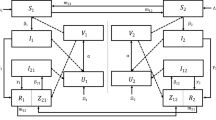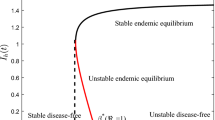Abstract
In this paper, a non-linear stage-structured model has been formulated to study the effects of primary/secondary dengue infection on children and adults. It is assumed that a proportion of susceptible children have been previously infected by a serotype asymptomatically. After recovery from asymptomatic infection, the immunity is developed for the particular serotype but they remain susceptible to heterologous serotypes. These children may get secondary infection when exposed to a different serotype. The model has two equilibrium states. Global/local stability of equilibrium states have been discussed. The stability of disease-free state changes at \(R_0=1\). Applying the center manifold theory, the existence of forward bifurcation is possible. This concludes that the primary/secondary infection in children as well as in adults population could be eradicated for \(R_0<1\). Numerical results are used to explore the global behavior of disease-free/endemic state for choice of arbitrary initial conditions.






Similar content being viewed by others
References
http://www.cdc.gov/dengue/symptoms. Accessed Sept 2015
Gubler, D.J., Kuno, G.: Dengue and Dengue Hemorrhagic Fever. CAB International, London (1997)
Kalayanarooj, S., Nimmannitya,S.: Clinical and laboratory presentations of dengue patients with different serotypes. Dengue Bull. 24, 53–59 (2000)
Sharp, T.W., Wallace, M.R., Hayes, C.G., Sanchez, J.L., et al.: Dengue fever in U.S. troops during Operation Restore Hope, Somalia, 1992–1993. Am. J. Trop. Med. Hyg. 53(1), 89–94 (1995)
http://patient.info/in/doctor/dengue-fever-pro. Accessed Sept 2016
Gibson, G., et al.: From primary care to hospitalization: clinical warning signs of severe dengue fever in children and adolescents during an outbreak. Brazil. Cad. Sade Pblica, Rio de Janeiro 29(1), 82–90 (2013)
Alera, M.T., et al.: Incidence of Dengue Virus Infection in Adults and Children in a Prospective Longitudinal Cohort in the Philippines. PLoS Negl. Trop. Dis. 10(2), e0004337 (2016)
Deen, J.L., Harris, E., Wills, B., et al.: The WHO dengue classification and case definitions: time for a reassessment. Lancet 368, 170–173 (2006)
Sabin, A.B.: Research on dengue during World War II. Am. J. Trop. Med. Hyg. 1(1), 30–50 (1952)
L’Azou, M., Moureau, A., Sarti, E., Nealon, J., et al.: Symptomatic dengue in Children in 10 Asian and Latin American Countries. N. Engl. J. Med. 374(12), 1155–1166 (2016)
Pongsumpun, P.: Dengue model with age structure and two different serotypes. In: The 3rd international symposium on biomedical engineering (ISBME 2008)
Anderson, K.B., Chunsuttiwat, S., Nisalak, A., Mammen, M.P., et al.: Burden of symptomatic dengue infection in children at primary school in Thailand: a prospective study. Lancet 369, 1452–9 (2007)
Rasul, C.H., Ahasan, H.A.M.N., Rasid, A.K.M.M., Khan, M.R.H.: Epidemiological factors of dengue hemorrhagic fever in Bangladesh. Indian Pediatr. 39, 369–372 (2002)
http://www.nation.lk/2010/05/09/news7.htm, The Nation, news, More adult dengue victims, By Carol Aloysius. Accessed Oct 2015
http://www.sanofipasteur.com/en/Documents/PDF/Dengue_Priority_for_Global_Health_EN_2013-09.pdf, Priority for Global Health EN 2013-09. Accessed Sept 2013
Halstead, S.B.: Dengue in the Americas and Southeast Asia: do they differ? Rev. Panam. Salud Publica. 20, 407–15 (2006)
Teixeira, M.G., Costa, M.C., Barreto, M.L., Mota, E.: Dengue and dengue hemorrhagic fever epidemics in Brazil: what research is needed based on trends, surveillance, and control experiences? Cad. Saude Publica. 21, 1307–15 (2005)
Teixeira, M.G., Costa, M.C.N., Barreto, M.L.: Recent shift in age pattern of dengue hemorrhagic fever. Brazil. Emerg. Infect Dis. 14(10), 1663 (2008)
Guzman, M.G., Kouri, G., Bravo, J., Valdes, L., Vazquez, S., Halstead, S.B.: Effect of age on outcome of secondary dengue 2 infections. Int. J. Infect. Dis. 6, 118–24 (2002)
Pongsumpun, P., Tang, I.M.: Transmission of dengue hemorrhagic fever in an age structured population. Math. Comput. Model. 37, 949–961 (2003)
Feng, Z., Velsco-Hernandez, J.X.: Competitive exclusion in a vector-host model for the Dengue fever. J. Math. Biol. 35, 523–544 (1997)
Superianta, A.K., Soewono, E., Van Gils, S.A.: A two age class dengue transmission model. Math. Biosci. 216, 114–121 (2008)
Pongsumpun, P.: Age structured model for symptomatic and asymptomatic dengue infections. In: Proceeding of ASM’07 The 16th IASTED international conference on applied simulation and modelling, pp. 348–352 (2007)
Vargas, C.S.: Mathematical Model for Dengue Epidemics with Differential Susceptibility and Asymptomatic Patients using Computer Algebra. Lecture Notes in Computer Science, pp. 284–298. Springer, Berlin (2009)
Chikaki, E., Ishikawa, H.: A dengue transmission model in Thailand considering sequential infections with all four serotypes. J. Infect. Dev. Ctries. 3, 711–722 (2009)
Perko, L.: Differential Equations and Dynamical Systems, Texts in Applied Mathematics. Springer, New York (1991)
Jones, J.H.: Notes on \(R_{0}\). Department of Anthropological Sciences, Stanford University, Stanford (2007)
LaSalle, J.P.: The stability of dynamical systems. Regional Conference Series in Applied Mathematics, vol. 25. SIAM, Philadelphia (1976)
Castillo-Chavez, C., Song, B.: Dynamical models of tuberculosis and their applications. Math. Biosci. Eng. 1(2), 361–404 (2004)
Esteva, L., Vargas, C.: Analysis of a dengue disease transmission model. Math. Biosci. 150, 131–151 (1998)
Author information
Authors and Affiliations
Corresponding author
Appendix
Appendix
Center Manifold Analysis at \(R_0=1\)
consider a general system of ODEs with parameter \(\phi \):
Without loss of generality, it is assumed that \(x^*\) is the disease-free point for system (21) for all values of the parameter \(\phi \).i.e.
Lemma 2
[29] Assume:
-
(A1)
\(Q=D_xf(x^*,\phi ^*)\) is the linearization matrix of system (21) about the equilibrium \(x^*\) with \(\phi \) evaluated at \(\phi ^*\). Zero is a simple eigenvalue of Q and all other eigenvalues of Q have negative real parts;
-
(A2)
Matrix Q has a non-negative right eigenvector \(\omega \) and a left eigenvector \(\nu \) corresponding to the zero eigenvalue.
Let \(f_k\) denotes the kth component of f and
Then the local dynamics of system (20) around the state \(x^*\) are totally determined by \(\mathbf{a}\) and \(\mathbf{b}\).
-
1.
\(\mathbf{a}> 0, \mathbf{b}> 0\). When \(\phi < \phi ^*\) with \(|\phi -\phi ^*|\ll 1, x^*\) is locally asymptotically stable and there exists a positive unstable equilibrium. When \(\phi >\phi ^*\) with \(|\phi -\phi ^*|\ll 1, x^*\) is unstable and there exists a negative and locally asymptotically stable equilibrium.
-
2.
\(\mathbf{a}< 0, \mathbf{b}< 0\). When \(\phi <\phi ^*\) with \(|\phi -\phi ^*|\ll 1, x^*\) is unstable. When \(\phi >\phi ^*\) with \(|\phi -\phi ^*|\ll 1, x^*\) is locally asymptotically stable and there exists a positive unstable equilibrium.
-
3.
\(\mathbf{a}>0, \mathbf{b}< 0\). When \(\phi < \phi ^*\) with \(|\phi -\phi ^*|\ll 1, x^*\) is unstable and there exists a locally asymptotically stable negative equilibrium. When \(\phi >\phi ^*\) with \(|\phi -\phi ^*|\ll 1, x^*\) is stable and a positive unstable equilibrium appears.
-
4.
\(\mathbf{a}< 0, \mathbf{b}> 0\). When \(\phi -\phi ^*\) changes from negative to positive, \(x^*\) changes its stability from stable to unstable. Correspondingly, a negative unstable endemic equilibrium becomes positive and locally asymptotically stable.
Considering \(\beta _1\) to be the bifurcation parameter, \(\beta _1=\beta _1^{c}\) corresponds to \(R_0=1\):
The further analysis is as follows: Let \(\mathbf{{\delta }}=(\delta _1, \delta _2, \delta _3, \delta _4, \delta _5, \delta _6)^{T}\) be a right eigenvector associated with the zero eigenvalue. It is given by
or, the above system can be written as;
Solving above equations, the right eigenvector is given as
Further, the left eigenvector \(\nu =(\nu _1, \nu _2, \nu _3, \nu _4, \nu _5, \nu _6)^{T}\) associated with the zero eigenvalue such that \(\delta \cdot \nu =1\) is given as
Now, the left eigenvector is computed to be
Let us introduce \(S=x_1, I_1=x_2, I_2=x_3, A=x_4, I_3=x_5, V=x_6\). The system (12)–(17) becomes,
The non-zero partial derivatives at the disease-free state (\(E_0\)) are turn out to be
The rest of the partial derivatives at \(E_0\) remain zero. From Lemma 2, the coefficients \(\mathbf{a}\) and \(\mathbf{b}\) are computed as,
By substituting the partial derivatives and the left and right eigenvectors from above analysis, the \(\mathbf{a}\) and \(\mathbf{b}\) are as follows:
It is observed that \(\mathbf{a}<0\) and \(\mathbf{b}>0\) always. Using Lemma 2, forward bifurcation is possible only and the endemic point is found to be locally asymptotically stable for \(R_0>1\).
Next Generation Matrix Method [27]
The next generation matrix is defined as the square matrix K in which the \(ij^{th}\) element of \(K, k_{ij}\), is the expected number of secondary infections of type i caused by a single infected individual of type j by assuming that the population of type i is completely susceptible. That is, each element of the matrix K is a reproduction number, but one where who infects whom is accounted for [27]. The spectral radius of K is the basic reproduction number. The spectral radius is the also known as the dominant eigenvalue of K. The next generation matrix has a number of desirable properties from a mathematical standpoint. In particular, it is a non-negative matrix and as such, it is guaranteed that there will be a single, unique eigenvalue which is positive, real, and strictly greater than all the others. Consider the next generation matrix K. It is comprised of two parts: F and \(Y^{-1}\), where
The \(F_i\) are new infections while \(Y_i\) are the transfer of infections from one compartment to another. The \(x_0\) is a disease-free state. The \(R_0\) is the dominant eigenvalue of the matrix \(K=FV^{-1}\).
Rights and permissions
About this article
Cite this article
Mishra, A., Gakkhar, S. Stage-Structured Transmission Model Incorporating Secondary Dengue Infection. Differ Equ Dyn Syst 29, 569–584 (2021). https://doi.org/10.1007/s12591-017-0387-1
Published:
Issue Date:
DOI: https://doi.org/10.1007/s12591-017-0387-1




